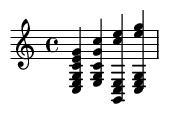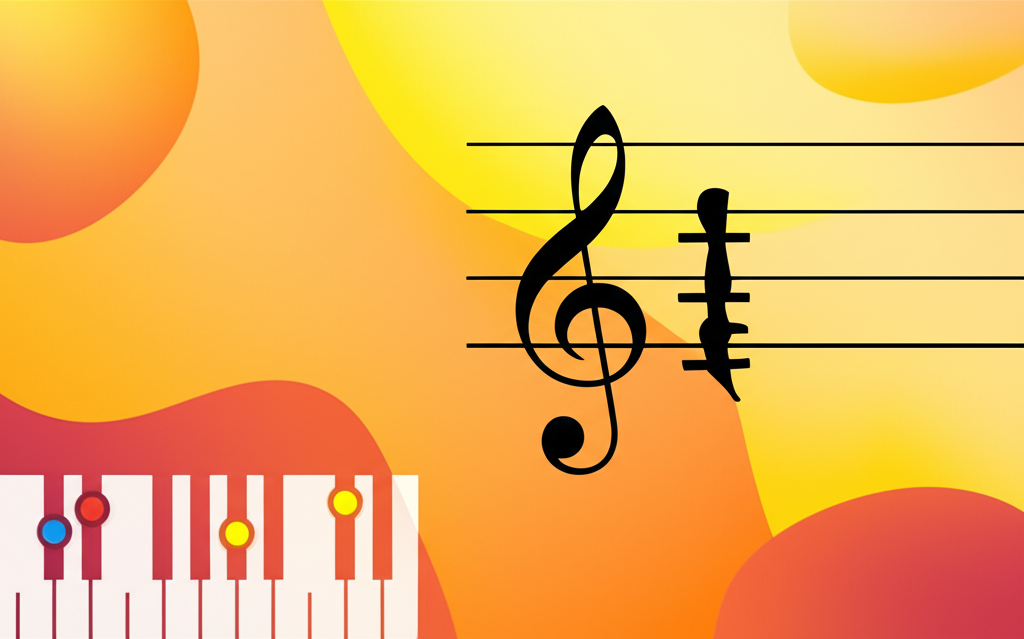Summary:
Major chords are the bedrock of Western music, creating the bright, resolved, and "happy" sounds that power countless songs across every genre. This definitive guide breaks down their theoretical structure, construction, inversions, and versatile applications, providing essential knowledge for musicians, songwriters, and curious listeners at all levels.
Keywords:
Major chord, triad, major third, perfect fifth, consonance, harmony, chord construction, root position, inversions, tonic chord, music theory, chord progressions.
Introduction:
What do a Beethoven symphony, a Taylor Swift anthem, and a classic blues tune have in common? At their core, they all rely on the power of the major chord. With its bright, resolute, and stable sound, the major chord is arguably the most fundamental building block in Western music. It's the sound of resolution, of joy, and of "home" in a musical phrase.
For anyone learning an instrument, writing a song, or simply wanting to understand music more deeply, mastering the major chord is the essential first step. In this article, we'll dissect what makes a major chord "major," how to build one from any note, and the countless ways these powerful chords shape the music we love.
Structure and Components of a Major Chord
A major chord is a type of triad, which means it's a three-note chord. It's built by stacking specific musical intervals on top of a starting note, called the root.
The three components are:
- The Root: The foundational note that gives the chord its name (e.g., the note C in a C major chord) .
- The Major Third: A note that is 4 semitones (or 2 whole steps) above the root. This interval is what gives the major chord its characteristic "bright" or "happy" quality.
- The Perfect Fifth: A note that is 7 semitones (or 3½ whole steps) above the root. The perfect fifth adds stability and strength, reinforcing the root.
Think of it like building a house: the root is the solid foundation, the major third provides the bright, open-feeling walls, and the perfect fifth is the sturdy roof that completes the structure.
The Major Chord Formula:
You can build a major chord from any starting note using this simple formula:
Formula by Scale Degrees: Root (1) + Major 3rd (3) + Perfect 5th (5)
Formula by Semitones: Root + 4 semitones + 3 semitones
Building a C Major Chord:
Let's apply the formula to build a C major chord. We start with C as our root. We find the major third (E) by counting 4 semitones up from C. Then, we find the perfect fifth (G) by counting 7 semitones up from C. The result is the C-E-G triad.

Major Chords in All 12 Keys
Using the same formula, you can construct a major chord starting on any of the 12 notes in Western music.
C major: C - E - G
C#/Db major: C# - F - G# | Db - F - Ab
D major: D - F# - A
Eb major: Eb - G - Bb
E major: E - G# - B
F major: F - A - C
F#/Gb major: F# - A# - C# | Gb - Bb - Db
G major: G - B - D
Ab major: Ab - C - Eb
A major: A - C# - E
Bb major: Bb - D - F
B major: B - D# - F#
Major Chords in Action: The I-IV-V Progression
The most common and powerful chord progression in pop, rock, country, and folk music is the I-IV-V (one-four-five) progression. In any major key, these three chords are all major and form the harmonic backbone of countless hits. In the key of C Major, the I, IV, and V chords are C major, F major, and G major.

Changing the Flavor: Chord Inversions
You don't always have to play the root note at the bottom. By rearranging the same three notes, you can create inversions. Inversions have a slightly different feel and are essential for creating smooth transitions between chords (a technique called voice leading) .
- Root Position: The root is the lowest note (e.g., C-E-G). This is the most stable and powerful sounding version.
- First Inversion: The third is the lowest note (e.g., E-G-C). It sounds a bit lighter and is often used as a passing chord.
- Second Inversion: The fifth is the lowest note (e.g., G-C-E). This version sounds the least stable and often wants to resolve to another chord.
C Major Chord Inversions Example:

Beyond the Triad: Extensions and Voicings
While the basic major triad is powerful, musicians often add more notes to create richer, more complex sounds. These are called extensions. A voicing refers to how the notes of a chord (including extensions) are arranged or spaced out.
Common extensions to a major chord include:
- Major 6th (maj6): Adding the 6th note of the scale (e.g., C-E-G-A for Cmaj6). Adds a sweet, nostalgic sound.
- Major 7th (maj7): Adding the 7th note of the scale (e.g., C-E-G-B for Cmaj7). Adds a jazzy, sophisticated, and relaxed feel.
- Major 9th (maj9): Adding the 9th note of the scale (e.g., C-E-G-B-D for Cmaj9). Creates a lush, modern sound.
These extensions add new colors to the fundamental "major" quality without erasing its inherent brightness.
From a Triad to a Major 7th Chord:

Famous Songs Built on Major Chords
Listen closely, and you'll hear major chords driving the world's most popular music. Here are a few iconic examples:
- "La Bamba" (Ritchie Valens) : A perfect example of the I-IV-V progression, using just C, F, and G major chords.
- "Sweet Home Alabama" (Lynyrd Skynyrd): Built on a simple, unforgettable riff using D, C, and G major chords.
- "Brown Eyed Girl" (Van Morrison): The joyful intro and verses cycle through a classic G-C-G-D progression.
- "Let It Be" (The Beatles): A masterclass in the I-V-vi-IV progression (C-G-Am-F). Notice how the three major chords provide a foundation of hope around the one minor chord.
- "Twist and Shout" (The Beatles): The energy comes from a driving I-IV-V progression in D major: D-G-A.
Historical Context: Why Do Major Chords Sound "Right"?
The dominance of the major chord isn't just a cultural preference; it's rooted in physics. The notes of a major triad are present in the natural harmonic series of a single vibrating pitch. The first few overtones produced by a string or column of air naturally outline a major chord, which is why our ears perceive it as pure, stable, and consonant.
During the Renaissance, this natural consonance was codified into music theory. By the Common Practice Period (roughly 1650-1900), major-minor tonality became the dominant system in Western music, with the major chord serving as the ultimate point of stability and resolution. Even in modern jazz and experimental music, the major chord remains the fundamental reference point from which all other harmonic complexity departs.
Playing Major Chords On Different Instruments
On Piano:
Major chords are intuitive on the piano. For a C major chord in root position with your right hand, you typically use fingers 1 (thumb), 3 (middle), and 5 (pinky) to play C, E, and G simultaneously. The shape remains consistent as you move up and down the keyboard.
On Guitar:
Guitar offers multiple ways to play each chord. Open chords like C major and G major use a combination of fretted notes and open strings. To play any major chord anywhere on the neck, guitarists learn movable "barre chord" shapes. The F major barre chord shape, for example, can be moved up the neck to create F#, G, G#, and so on.
- Open G Major: 3rd fret (low E), 2nd fret (A), open D, open G, open B, 3rd fret (high E).
- F Major Barre Chord: Place your index finger across all six strings at the 1st fret (the "barre") and form an E major shape with your other fingers.
On Ukulele:
Ukulele chords are often simple and easy to learn. A C major chord requires just one finger: press the 3rd fret of the bottom A string and strum all four strings. A G major chord is also common, using three fingers to form a small triangle shape on the C, E, and A strings.
Fun Facts About Major Chords
- The major chord is often called the "happy chord." Studies in music psychology confirm that listeners across cultures consistently associate major keys and chords with positive emotions like joy and triumph.
- The term "major" comes from the Latin word for "greater," referring to the larger (major) third interval that defines the chord's sound.
- The most common chord progression in modern pop, often called the "Four Chord Song" or "Axis of Awesome" progression, is I-V-vi-IV. It features three major chords and one minor chord, creating a perfect blend of stability and emotion.
- The Beach Boys' "Good Vibrations" creates its otherworldly psychedelic feel by shifting rapidly between major chords in unexpected, unrelated keys.
Conclusion: Your Foundation for Musical Mastery
The major chord is far more than a simple three-note structure; it is the sonic foundation of Western music. Its bright, consonant quality provides the musical "home base" that composers and songwriters have used for centuries to create feelings of joy, stability, and resolution.
Understanding how to build, recognize, and use major chords is the single most important step in developing musical literacy. From this foundation, you can explore the entire universe of harmony, from dark minor chords to complex jazz extensions, always knowing you have a connection back to these fundamental building blocks.
As you continue your musical journey, train your ear to hear the distinctive sound of major chords. Notice how they anchor a song's chorus, resolve tension after a bridge, and lift your spirits. By internalizing these structures, you'll gain a much deeper appreciation for the architecture of the music you love—and unlock the power to create it yourself.
References:
Kostka, S., & Payne, D. (2018). Tonal Harmony: With an Introduction to Post-Tonal Music (8th ed.). McGraw-Hill Education.
Levine, M. (2011). The Jazz Theory Book. O'Reilly Media.
Aldwell, E., Schachter, C., & Cadwallader, A. (2018). Harmony and Voice Leading (5th ed.). Cengage Learning.
Tagg, P. (2014). Everyday Tonality II: Towards a Tonal Theory of What Most People Hear. The Mass Media Music Scholars' Press.
Harrison, M. (2017). Contemporary Music Theory: The Essential Guide. Hal Leonard Corporation.
